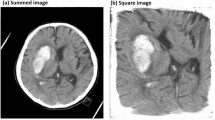Abstract
A brain haemorrhage is a form of stroke that occurs when a blood vessel in the brain bursts, producing bleeding in the surrounding tissues. The accurate assessment of malady and the excavation of robust and reliable measurements for sick people to define the morphological brain changes as the recovery developments are made possible by the ability to diagnose brain haemorrhage, which is primarily done through the investigation of a CT scan. Even though much research has indeed been accomplished on medical image segmentation, there’s still some potential for more studies in the context of brain haemorrhage prognosis considering the low accuracy of prevailing techniques and algorithms, programming uncertainty of developed approaches, preposterousness in the real world, and a dearth of many other advancements that could make the process quite impactful and beneficial. Furthermore, many of the current techniques only target the identification of a small number of brain haemorrhage subtypes. In this paper, we are focusing on the application of convolution neural networks, which is a deep learning technique to detect brain haemorrhage, and we found that the classification accuracy of the model is 89.9%.
Access this chapter
Tax calculation will be finalised at checkout
Purchases are for personal use only
Similar content being viewed by others
References
Arif, M., Abdullah, N.A., Phalianakote, S.K., Ramli, N., Elahi, M.: Maximizing information of multimodality brain image fusion using curvelet transform with genetic algorithm. In: 2014 International Conference on Computer Assisted System in Health (CASH). IEEE, pp. 45–51 (2014)
Vishnuvarthanan, G., Pallikonda Rajasekaran, M., Subbaraj, P., Vishnuvarthanan, A.: An unsupervised learning method with a clustering approach for tumor identification and tissue segmentation in magnetic resonance brain images. Appl. Soft Comput. 38, 190–212 (2016)
Singh, S., Deep Gupta, R.S., Anand, V.K.: Nonsubsampled shearlet based CT and MR medical image fusion using biologically inspired spiking neural network. Biomed. Signal Process. Control 18, 91–101 (2015). https://doi.org/10.1016/j.bspc.2014.11.009
Ganesan, R., Radhakrishnan, S.: Segmentation of computed tomography brain images using genetic algorithm. Int. J. Soft Comput. 4(4), 157–161 (2009)
Li, C.L., Goldgof, D.B., Hall, L.O.: Knowledge-based classification and tissue labeling of MR images of human brain. IEEE Trans. Med. Imaging 12, 740–750 (1993)
Laidlaw, D., Fleischer, K., Barr, A.: Partial-volume Bayesian classification of material mixtures in MR volume data using voxel histograms. IEEE Trans. Med. Imaging 17, 74–86 (1998)
Wells, W.M., Grimson, W.E.L., Kikinis, R., Jolesz, F.A.: Adaptive segmentation of MRI data. IEEE Trans. Med. Imaging 15(4), 429–442 (1996)
Loncaric, S., Majcenica, Z.: Multiresolution simulated annealing for brain image analysis. Medical Imaging 1999: Image Processing, vol. 3661, pp. 1139–1146 (1997). Accessed 15 Aug 2010
Prastawa, M., et al.: A brain tumor segmentation framework based on outlier detection. Med. Image Anal. 8, p275-283 (2003)
Cuadra, M.B., Cuisenaire, O., Meuli, R., Thiran, J.P.: Automatic segmentation of internal structures of the brain in MR images using a tandem of affine and non-rigid registration of an anatomical brain atlas. In: Proceedings 2001 International Conference on Image Processing (Cat. No. 01CH37205), vol. 3. IEEE, pp. 1083–1086 (2001, October)
Mohamed, R.: Comparative study of edge detection algorithms applying on the grayscale noisy image using morphological filter. GVIP J. 6(4), 17–23 (2006)
Liu et al.: Hemorrhage slices detection in brain CT images. In: 19th International Conference on Pattern Recognition, 2008 (ICPR 2008), pp. 1–4. IEEE, Tampa, FL, 23 January 2009 (2009)
Loncaric, M.: Quantitative intracerebral brain hemorrhage analysis (1997)
Rajpurkar, P., Hannun, A.Y., Haghpanahi, M., Bourn, C., Ng, A.Y.: Cardiologist-Level Arrhythmia Detection with Convolutional Neural Networks (2017)
Lieman-Sifry, J., Le, M., Lau, F., Sall, S., Golden, D.: FastVentricle: cardiac segmentation with ENet. CoRR, vol. abs/1704.04296 (2017)
Lee, K., Zung, J., Li, P., Jain, V., Sebastian Seung, H.: Superhuman accuracy on the SNEMI3D connectomics challenge. CoRR, vol. abs/1706.00120 (2017)
Chen, K., Wang, J., Chen, L.-C., Gao, H., Xu, W., Nevatia, R.: ABC-CNN: an attention based convolutional neural network for visual question answering. CoRR (2015)
Ba, J., Mnih, V., Kavukcuoglu, K.: Multiple object recognition with visual attention. CoRR, vol. abs/1412.7755 (2014)
Zagoruyko, S., Komodakis, N.: Paying more attention to attention: improving the performance of convolutional neural networks via attention transfer. CoRR (2016)
Chen, L.-C., Yang, Y., Wang, J., Xu, W., Yuille, A.L.: Attention to Scale: Scale-aware Semantic Image Segmentation (2015)
Author information
Authors and Affiliations
Corresponding author
Editor information
Editors and Affiliations
Rights and permissions
Copyright information
© 2023 The Author(s), under exclusive license to Springer Nature Switzerland AG
About this paper
Cite this paper
Navadia, N.R., Kaur, G., Bhardwaj, H. (2023). Brain Hemorrhage Detection Using Deep Learning: Convolutional Neural Network. In: Garg, L., et al. Information Systems and Management Science. ISMS 2021. Lecture Notes in Networks and Systems, vol 521. Springer, Cham. https://doi.org/10.1007/978-3-031-13150-9_46
Download citation
DOI: https://doi.org/10.1007/978-3-031-13150-9_46
Published:
Publisher Name: Springer, Cham
Print ISBN: 978-3-031-13149-3
Online ISBN: 978-3-031-13150-9
eBook Packages: Intelligent Technologies and RoboticsIntelligent Technologies and Robotics (R0)




